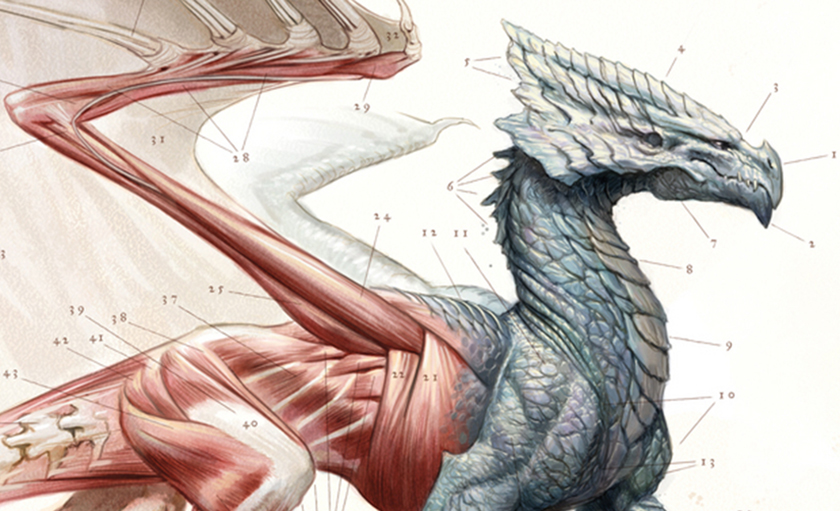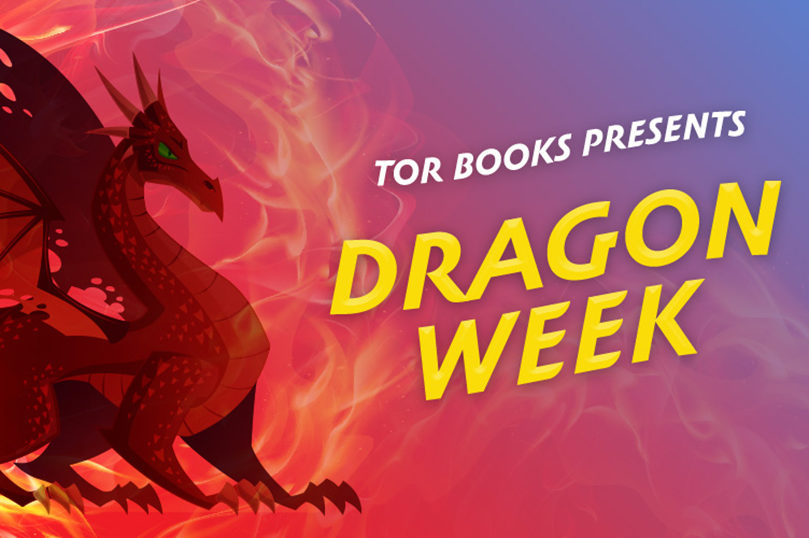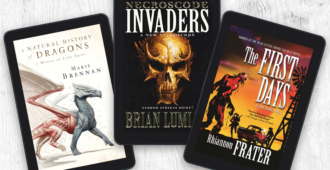Welcome to Dragon Week, a celebration of all things Dragon!
We’ve been a little hard on dragons so far. We’ve talked about the deadliest dragons, and how to survive an encounter with a dragon (trickery, seduction, and the magic of friendship were on table.)
So today we’re sobering up with a more serious issue, brought to you by Marie Brennan, author of A Natural History of Dragons and Turning Darkness Into Light.

“Real Conservation Needs Teeth, Not Talk”
By Tamara Lewis, Opinion Writer, Falchester Weekly Review
These days it seems like dragon conservation is the hot new cause for celebrity figures, with everyone from actors to politicians to socialites being photographed with adorable dragon hatchlings.
But these photographs obscure the reality, and in some cases contribute to the very harm they’re attempting to mitigate. Don’t let the gangly appearance of a baby Akhian desert drake fool you; just out of the frame there’s undoubtedly an experienced handler waiting with a tranquilizer dart, ready to shoot the dragon if it tries to take a piece off the celebrity. Far too many people believe that if a dragon is raised in captivity, it will become tame and cooperative around humans.
On occasion this is true. The“guard dragon” swamp-wyrms of the oba of Bayembe are a famous attraction for tourists, as are the performing ci lêng of Yelang. Producing such a result, however, requires years of painstaking and expert work, and even then, accidents are all too common — and all too fatal. A private individual attempting to raise a dragon in his barn or her cellar is likely to wind up in the hospital sooner rather than later.
Furthermore, these environments are rarely healthy for the dragon. The Trent Draconic Rescue Center in Linshire is home to dozens of dragons whose health problems preclude them ever being released back into the wild, thanks to an early life spent with improper food and insufficient room to move. Nor are they socialized to deal with their own kind, who would swiftly kill them if they were to return.
Smaller breeds such as honeyseekers do offer a safer alternative, and in fact many people successfully keep them as pets. But although the dragons themselves are healthy and their owners are unharmed, the trade in honeyseeker eggs and breeding pairs threatens the long-term stability of wild populations. They used to be a common sight on many islands in the Broken Sea, but now their natural range has shrunk alarmingly, with their numbers being reduced past the point of viability by hunters armed with snares and nets. Although the species may survive in captivity, this cannot be called good conservation.
It would be far preferable, not to mention more effective, if these celebrities spent less time posing for pictures with dragons and more on raising awareness of measures that would truly help preserve the diversity of dragon species in their natural habitats. Better agricultural practices would leave more untouched terrain for dragon reproduction and hunting, and we must hold our industries accountable for the pollution that has reduced sea-serpents to an alarmingly small fraction of their previous numbers.
Successfully doing this requires more than a mere photo opportunity. National initiatives to set aside nature reserves may seem like a wonderful move, but without ongoing support and monitoring, poachers can easily slip in to hunt at will, taking skins, claws, teeth, and living specimens. Given the financial incentives to sell such materials on the black market, it’s no wonder that merely designating a protected space does little good.
For these measures to work, community involvement at the local level is vital. The traditional practices in the Keongan Islands have been remarkably effective at maintaining healthy fire-lizard populations there, because there is social value in protecting the dragons rather than selling them. Even a single person can make a difference, as in southern Coyahuac, where the influence of Zocachitl yec Tecehuitzo has done a great deal to stabilize the future of quetzalcoatls. Her connections in the government show how top-down initiatives can be translated to real action on the ground, creating sustainable tourism programs to view a queztalcoatl in the wild.
Our celebrities could use their own influence to support these efforts on the ground in the places where dragons still thrive. Whether this is via fundraising for local organizations or campaigning against the foreign policy decisions that drive a great deal of habitat loss, they do have a role to play. We also commend Rebecca Susskind for publicly decrying the use of drakefly feathers in high fashion — for it is our demand for these rarities that makes the illicit trade in them so lucrative.
Change must happen around the world if we want our grandchildren and their grandchildren to enjoy the beauty and majesty of dragons.
Order Your Copy of Turning Darkness Into Light:











